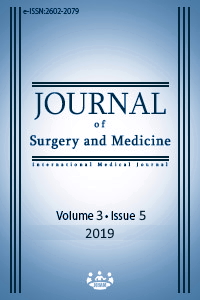Etiology of anemia in children aged between 6 months and 18 years
Keywords:
Anemia etiology, Iron-deficiency anemia, Thalassemia minor, Screening, Vitamin B12 deficiencyAbstract
Aim: Anemia is an important public health problem that concerns human and community health. In this study, we aimed to determine the etiology of anemia in different age groups and create social awareness.
Methods: The study (retrospective cohort study) included anemia patients between 6 months and 18 years old who applied to the Pediatric Hematology and Oncology Outpatient Clinic of KSU Medical Faculty between January 2015 and January 2018.
Results:1120 patients were included in the study. There were 873 with iron deficiency anemia, 184 with thalassemia minor, 25 with vitamin B12 deficiency anemia, 13 with autoimmune hemolytic anemia, 10 with hereditary spherocytosis and the other etiology of anemia. While 16.4% of all patients and 33.8% of patients aged 6-12 years had thalassemia minor. On the other side, 81.3% of patients aged 6 months-2 years, 74.3% of patients aged 2-6 years, 60.4% of patients aged 6-12 years and 85.0% of patients aged 12-18 years had iron-deficiency anemia. Iron deficiency anemia was common in males (60.2%) in the 2-6 years age group (P=0.002), but it was common in females (80.6%) in the 12-18 years age group (P<0.001).
Conclusion: As a result of this study, it has been concluded that screening and iron supplementation should be done in societies at risk.
Downloads
References
Akca SO, Bostanci MÖ. The impact of anemia and body mass index (BMI) on neuromotor development of preschool children. Rev Assoc Med Bras. 2017;63(9):779-86.
Janus J, Moerschel, SK. Evaluation of anemia in children. Am. Fam. Physician 2010;81(12):1462-71.
Zimmermann MB, Hurrell RF. Nutritional iron deficiency. Lancet 2007;370:511-20.
Iannotti LL, Tielsch JM, Black MM, Black RE. Iron supplementation in early childhood. Am J Clin Nutr. 2006;84(6):1261-76.
Lisboa MBMC, Oliveira EO, Lamounier JA, Silva CAM, Freitas RN. Prevalence of iron-deficiency anemia in children aged less than 60 months: A population-based study from the state of Minas Gerais, Brazil. Rev Nutr. 2015;28(2):121-31.
Stevens GA, Finucane MM, De-Regil LM, Paciorek CJ, Flaxman SR, Branca F, etal. Global, regional, and national trends in hemoglobin concentration and prevalence of total and severe Anemia in children and pregnant and non-pregnant women for 1995–2011: a systematic analysis of population-representative data. Lancet Glob Health 2013;1:e16–25.
Akkermans MD, Eussen SR, van der Horst-Graat JM, van Elburg RM, van Goudoever JB, Brus F. A micronutrient-fortified young-child formula improves the iron and vitamin D status of healthy young European children: a randomized, double-blind controlled trial. Am J Clin Nutr. 2017;105(2):391-9.
Irwin JJ, Kirchner JT. Anemia in children. Am Fam Physician. 2001;64(8):1379-86.
Zuffo CR, Osório MM, Taconeli CA, Schmidt ST, da Silva BH, Almeida CC. Prevalence and risk factors of anemia in children. J Pediatr (Rio J). 2016;92(4):353-60.
Balcı YI, Karabulut A, Gürses D, Çövüt IE. Prevalence and risk factors of anemia among adolescents in Denizli, Turkey. Iran J Pediatr. 2012;22(1):77-81.
Balarajan YS, Fawzi WW, Subramanian SV. Changing patterns of social inequalities in Anemia among women in India: crosssectional study using nationally representative data. BMJ Open. 2013;3:e002233.
Muriuki JM, Mentzer AJ, Kimita W, Ndungu FM, Macharia AW, Webb EL, etal. Iron Status and Associated Malaria Risk Among African Children. Clin Infect Dis. 2018 Sep 14.
André HP, Sperandio N, Siqueira RL, Franceschini SDCC, Priore SE. Food and nutrition insecurity indicators associated with iron deficiency anemia in Brazilian children: a systematic review. Cien Saude Colet. 2018;23(4):1159-67.
Schneider JM, Fujii ML, Lamp CL, Lönnerdal B, Dewey KG, Zidenberg-Cherr S. The use of multiple logistic regression to identify risk factors associated with anemia and iron deficiency in a convenience sample of 12-36-mo-old children from low-income families. Am J Clin Nutr. 2008;87(3):614-20.
Koc A, Kosecik M, Vural H, Erel O, Ataş A, Tatli MM. The frequency and etiology of anemia among children 6-16 years of age in the southeast region of Turkey. Turk J Pediatr. 2000;42(2):91–5.
Cesur M, Temiz F, Acıpayam C, Kılınc M, AkkececiSeringec N. Disordered bone metabolism in hereditary spherocytosis patients. Hematology 2019;24(1):276-81.
Weatherall DJ. The inherited diseases of hemoglobin are an emerging global health burden. Blood. 2010;115(22):4331-6.
Taher AT, Weatherall DJ, Cappellini MD. Thalassaemia. Lancet. 2018;391(10116):155-67.
Downloads
- 1372 1872
Published
Issue
Section
How to Cite
License
Copyright (c) 2019 Ömer Duyuran, Can Acıpayam, Nurten Seringeç Akkeçeci, Sevcan İpek, Rumeysa Duyuran
This work is licensed under a Creative Commons Attribution-NonCommercial-NoDerivatives 4.0 International License.
















